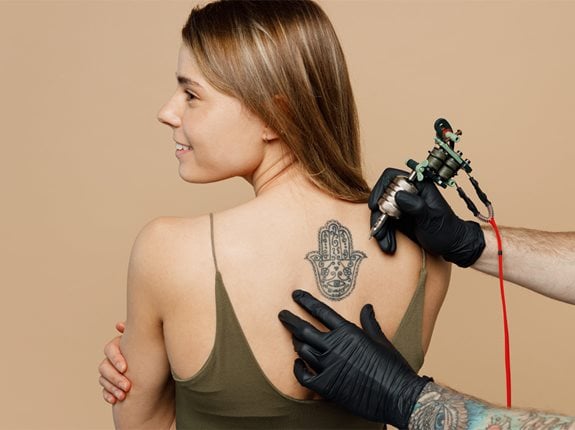...
Napisał(a)
Widze, że jesteś "po przejściach" więc będę mógł zasięgnąć u Ciebie rady. Otóż byłem przed ok. 2 laty endokrynologa, który stwierdził u mnie ginekomastię pokwitaniową. Dodam, że obecnie mam 17 lat a gino zauważyłem ok. 3 lat temu, niebrałem żadnych sterydów itp. U ciebie sutki [przed operacją] wyglądały wporzo, są całkiem płaskie lecz wrażenie nienaturalnie dużych sprawiaja piersi. U mnie piersi są jeszcze znośne, mniejsze niż Twoje, natomiast sutki są strasznie nabrzmiałe.Kiedyś czułem wyraźnie twardą grudkę pod kazdym z sutków, dziś w tych okolicach daje się wyczuć miękką substancję, jakby tłuszcz i tu rodzi się pytanie czy gino zanikło mi, a powstała lipomastia? Czekam na odp. i z góry serdecznie dziękuję. Pzdr.
...
Napisał(a)
17 lat to jeszcze torche wszesnie, poczekaj jeszcze z 2 lata jak nie zniknie to skalpel ja po nowym roku startuje i juz sie doczekac nie moge kiedy sie pozbede tego gowna
...
Napisał(a)
A nielepiej Ci wypróbowac nolve lub andractim, albo inne środki? W sumie wiem, że 17 lat to troche mało ale ja gino mam 3 lata, a powinno zniknąć po 2-óch [tak czytałem gdzieś]. Odpowiedzcie na pytanie zamieszczone w powyższym poście!
...
Napisał(a)
Ja tez mam to samo klatke mam normalna tylko sutki troche powiekszone znaczy takie gladnie czy cos.......to jest gino niby cos tam jest ale to jest bardziej mieeki niz twarde :P
co na to moze pomoc :P
co na to moze pomoc :P
...
Napisał(a)
No własnie, ale gino to twarde grudki pod sutami, a mi te grudki zanikły i pozostał jakby tłuszcz. Czy to możliwe zeby następstwem ginekomastii pokwitaniowej była lipomastia?
...
Napisał(a)
nie truj sie nolvą, szkoda kasy i zdrowia jak nie amsz kasy na zabieg to z tym zyj moze samo zejdzie ale na chemie za bardzo nie licz ze cos pomoze. Sam probowalem i efektow 0
...
Napisał(a)
A jakie po tym moga wystapić uszczerbki na zdrowiu? Słyszałem, że w 80% pomaga ...
...
Napisał(a)
w 80%? jak jestes na cyklu i cos sie zaczyna dziac to pomoze bo zachamuje ilosc estrogenow ale jak masz juz gino bez koksu to watpie aby pomoglo, sam mam gino od koksu i po trzech latach zaczolem to zwalczac ale bezskutecznie teraz sie w****ilem i skalpel. Od nolvy raczej nie umrzesz ale obciazasz watrobe bo dawki sa dos duze i przez dlugi okres czasu cos tam jeszcze mi swita ze gdzies czytalem ze nolva powoduje zwiekszone ryzyko choroby raka ale nie potwierdzam tego na 100%. Mowie co wiem. POZDRAWIAM
...
Napisał(a)
"Nolvadex jak na razie nie jest on zarejestrowany do leczenia ginekomastii. Zostało przeprowadzonych jednak szereg badań potwierdzających skuteczność tego leku w leczeniu gino. Oto raporty z kilku takich badań:
"Treatment of marked gynecomastia in puberty with tamoxifen
Kinderklinik, Universitat Mainz.
Based on the good results of another author 10 boys with marked pubertal gynecomastia were treated with the antioestrogen Tamoxifen (Nolvadex) at a dose of 20-40 mg/d orally for 2-12 months. In most cases the gynecomastia decreased totally, only two patients experienced palpable subareolar glandular tissue at the end of therapy. Side effects were not noted. During therapy levels of estradiol and testosteron increased, with a more pronounced elevation of estradiol. Basal values of LH and FSH remained nearly unchanged, but LH showed an increased response to LH-RH, which could be explained by the antioestrogenic effect of Tamoxifen at the hypothalamic level. The reduction of breast size in spite of increased estradiol levels on the other hand, suggests that the mean therapeutic effect of tamoxifen is through estrogen receptor blockade of breast tissue.
PMID: 3123765 [PubMed - indexed for MEDLINE]"
"Idiopathic gynecomastia treated with tamoxifen: a preliminary report
Department of Surgery, Queen Mary Hospital, University of Hong Kong.
Sixty-one Chinese men with idiopathic gynecomastia were treated with 40 mg of tamoxifen daily for one of four months (median, two months). Eighty percent had complete regression of their breast swelling. No long-term side effects of tamoxifen were observed over a median follow-up period of 36 months.
PMID: 3664552 [PubMed - indexed for MEDLINE]"
"Testosterone and estradiol levels in male gynecomastia. Clinical and endocrine findings during treatment with tamoxifen
[Article in German]
Oestradiol-(E2) levels in serum were significantly higher in a group of 91 males with gynaecomastia than in a control group. The levels were highest in patients with testicular tumour, hyperprolactinaemia and idiopathic gynaecomastia. In gynaecomastia of puberty and primary or secondary hypogonadism, the E2 level was within normal limits, but the testosterone/oestradiol ratio was significantly reduced. Tamoxifen, at a daily dose of 20 mg, was administered over 2-4 months to 16 patients with gynaecomastia. Of twelve patients with painful gynaecomastia ten became painfree. Gynaecomastia regressed partially or completely in 14 patients, in only 2 was it unchanged. There was no recurrence of gynaecomastia after discontinuing tamoxifen. Side-effects did not occur. It is concluded that tamoxifen is a promising alternative to the surgical treatment of gynaecomastia.
PMID: 6489180 [PubMed - indexed for MEDLINE]"
"Beneficial effects of raloxifene and tamoxifen in the treatment of pubertal gynecomastia.
Department of Pediatrics, University of Ottawa, Ontario, Canada. [email protected]
OBJECTIVES: To assess the efficacy of the anti-estrogens tamoxifen and raloxifen in the medical management of persistent pubertal gynecomastia. STUDY DESIGN: Retrospective chart review of 38 consecutive patients with persistent pubertal gynecomastia who presented to a pediatric endocrinology clinic. Patients received reassurance alone or a 3- to 9-month course of an estrogen receptor modifier (tamoxifen or raloxifene). RESULTS: Mean (SD) age of treated subjects was 14.6 (1.5) years with gynecomastia duration of 28.3 (16.4) months. Mean reduction in breast nodule diameter was 2.1 cm (95% CI 1.7, 2.7, P <.0001) after treatment with tamoxifen and 2.5 cm (95% CI 1.7, 3.3, P <.0001) with raloxifene. Some improvement was seen in 86% of patients receiving tamoxifen and in 91% receiving raloxifene, but a greater proportion had a significant decrease (>50%) with raloxifene (86%) than tamoxifen (41%). No side effects were seen in any patients. CONCLUSION: Inhibition of estrogen receptor action in the breast appears to be safe and effective in reducing persistent pubertal gynecomastia, with a better response to raloxifene than to tamoxifen. Further study is required to determine that this is truly a treatment effect.
PMID: 15238910 [PubMed - indexed for MEDLINE]"
"Tamoxifen therapy for painful idiopathic gynecomastia.
Department of Medicine, Fitzsimons Army Medical Center, Aurora, CO 80045-5001.
We have evaluated the efficacy of the antiestrogen tamoxifen in six men with painful idiopathic gynecomastia. Subjects were given either tamoxifen or placebo for 2 to 4 months and then were given the other agent for an identical period. Breast size was considered to have been reduced only if it had decreased by one or more Marshall-Tanner stages during the treatment period. Pain reduction with tamoxifen therapy was statistically significant for the group, occurring in five of six subjects during tamoxifen treatment and in only one of six during the placebo period. Size reduction with tamoxifen was only marginally significant for the entire group, but occurred in all three subjects who were initially in Marshall-Tanner stage III and in none of the three subjects who were initially in stage V. During tamoxifen treatment, there was a significant increase in the serum levels of luteinizing hormone and total estradiol and a marginally significant increment in the total testosterone level.
PMID: 2237557 [PubMed - indexed for MEDLINE]"
"Treatment of gynecomastia with tamoxifen: a double-blind crossover study.
Benign asymptomatic or painful enlargement of the male breast is a common problem, postulated to be due to an increased estrogen/testosterone ration or due to increased estrogenic or decreased androgenic stimulation via estrogen or androgen receptor interactions. Treatment at present consists of analgesic medication or surgery. However, treatment directed against the preponderance of estrogenic stimulation would seem to represent a more specific form of therapy. In the present double-blind crossover study, one-month courses of a placebo or the antiestrogen tamoxifen (10 mg given orally bid) were compared in random order. Seven of ten patients experienced a decrease in the size of their gynecomastia due to tamoxifen (P less than 0.005). Overall, the decrease for gynecomastia for the whole group was significant (P less than 0.01). There was no beneficial effect of placebo (P greater than 0.1). Additionally, all four patients with painful gynecomastia experienced symptomatic relief. There was no toxicity. The reduction of breast size was partial and may indicate the need for a longer course of therapy. A followup examination was performed in eight out of ten patients nine months to one year after discontinuing placebo and tamoxifen. There were no significant changes from the end of the initial study period except for one tamoxifen responder who developed a recurrence of breast tenderness after six months, and one nonresponder who demonstrated an increase in breast size and a new onset of tenderness after ten months. Therefore, antiestrogenic treatment with tamoxifen may represent a safe and effective mode of treatment for selected cases of cosmetically disturbing or painful gynecomastia.
PMID: 3526085 [PubMed - indexed for MEDLINE]"
Czyli ogólnie rzecz biorąc tamoxifen jest skuteczny w leczeniu ginekomastii idiopatycznej w 80% przypadków. W przeprowadzonych badaniach stosowano dawki 10-40mg dziennie przez 1-12 miesięcy. Pierwsze efekty pojawiały się nawet po miesiącu, jednak dla pełnego efektu lek należy stosować przez kilka miesięcy. Jest on bezpieczny w stosowaniu i stosunkowo tani. Polecam stosowanie 20mg Nolvadexu, aż do wyleczenia."
CZESC Z ARTYKULU benek94
A czy pomaga to kwestia organizmu chyba :/
"Treatment of marked gynecomastia in puberty with tamoxifen
Kinderklinik, Universitat Mainz.
Based on the good results of another author 10 boys with marked pubertal gynecomastia were treated with the antioestrogen Tamoxifen (Nolvadex) at a dose of 20-40 mg/d orally for 2-12 months. In most cases the gynecomastia decreased totally, only two patients experienced palpable subareolar glandular tissue at the end of therapy. Side effects were not noted. During therapy levels of estradiol and testosteron increased, with a more pronounced elevation of estradiol. Basal values of LH and FSH remained nearly unchanged, but LH showed an increased response to LH-RH, which could be explained by the antioestrogenic effect of Tamoxifen at the hypothalamic level. The reduction of breast size in spite of increased estradiol levels on the other hand, suggests that the mean therapeutic effect of tamoxifen is through estrogen receptor blockade of breast tissue.
PMID: 3123765 [PubMed - indexed for MEDLINE]"
"Idiopathic gynecomastia treated with tamoxifen: a preliminary report
Department of Surgery, Queen Mary Hospital, University of Hong Kong.
Sixty-one Chinese men with idiopathic gynecomastia were treated with 40 mg of tamoxifen daily for one of four months (median, two months). Eighty percent had complete regression of their breast swelling. No long-term side effects of tamoxifen were observed over a median follow-up period of 36 months.
PMID: 3664552 [PubMed - indexed for MEDLINE]"
"Testosterone and estradiol levels in male gynecomastia. Clinical and endocrine findings during treatment with tamoxifen
[Article in German]
Oestradiol-(E2) levels in serum were significantly higher in a group of 91 males with gynaecomastia than in a control group. The levels were highest in patients with testicular tumour, hyperprolactinaemia and idiopathic gynaecomastia. In gynaecomastia of puberty and primary or secondary hypogonadism, the E2 level was within normal limits, but the testosterone/oestradiol ratio was significantly reduced. Tamoxifen, at a daily dose of 20 mg, was administered over 2-4 months to 16 patients with gynaecomastia. Of twelve patients with painful gynaecomastia ten became painfree. Gynaecomastia regressed partially or completely in 14 patients, in only 2 was it unchanged. There was no recurrence of gynaecomastia after discontinuing tamoxifen. Side-effects did not occur. It is concluded that tamoxifen is a promising alternative to the surgical treatment of gynaecomastia.
PMID: 6489180 [PubMed - indexed for MEDLINE]"
"Beneficial effects of raloxifene and tamoxifen in the treatment of pubertal gynecomastia.
Department of Pediatrics, University of Ottawa, Ontario, Canada. [email protected]
OBJECTIVES: To assess the efficacy of the anti-estrogens tamoxifen and raloxifen in the medical management of persistent pubertal gynecomastia. STUDY DESIGN: Retrospective chart review of 38 consecutive patients with persistent pubertal gynecomastia who presented to a pediatric endocrinology clinic. Patients received reassurance alone or a 3- to 9-month course of an estrogen receptor modifier (tamoxifen or raloxifene). RESULTS: Mean (SD) age of treated subjects was 14.6 (1.5) years with gynecomastia duration of 28.3 (16.4) months. Mean reduction in breast nodule diameter was 2.1 cm (95% CI 1.7, 2.7, P <.0001) after treatment with tamoxifen and 2.5 cm (95% CI 1.7, 3.3, P <.0001) with raloxifene. Some improvement was seen in 86% of patients receiving tamoxifen and in 91% receiving raloxifene, but a greater proportion had a significant decrease (>50%) with raloxifene (86%) than tamoxifen (41%). No side effects were seen in any patients. CONCLUSION: Inhibition of estrogen receptor action in the breast appears to be safe and effective in reducing persistent pubertal gynecomastia, with a better response to raloxifene than to tamoxifen. Further study is required to determine that this is truly a treatment effect.
PMID: 15238910 [PubMed - indexed for MEDLINE]"
"Tamoxifen therapy for painful idiopathic gynecomastia.
Department of Medicine, Fitzsimons Army Medical Center, Aurora, CO 80045-5001.
We have evaluated the efficacy of the antiestrogen tamoxifen in six men with painful idiopathic gynecomastia. Subjects were given either tamoxifen or placebo for 2 to 4 months and then were given the other agent for an identical period. Breast size was considered to have been reduced only if it had decreased by one or more Marshall-Tanner stages during the treatment period. Pain reduction with tamoxifen therapy was statistically significant for the group, occurring in five of six subjects during tamoxifen treatment and in only one of six during the placebo period. Size reduction with tamoxifen was only marginally significant for the entire group, but occurred in all three subjects who were initially in Marshall-Tanner stage III and in none of the three subjects who were initially in stage V. During tamoxifen treatment, there was a significant increase in the serum levels of luteinizing hormone and total estradiol and a marginally significant increment in the total testosterone level.
PMID: 2237557 [PubMed - indexed for MEDLINE]"
"Treatment of gynecomastia with tamoxifen: a double-blind crossover study.
Benign asymptomatic or painful enlargement of the male breast is a common problem, postulated to be due to an increased estrogen/testosterone ration or due to increased estrogenic or decreased androgenic stimulation via estrogen or androgen receptor interactions. Treatment at present consists of analgesic medication or surgery. However, treatment directed against the preponderance of estrogenic stimulation would seem to represent a more specific form of therapy. In the present double-blind crossover study, one-month courses of a placebo or the antiestrogen tamoxifen (10 mg given orally bid) were compared in random order. Seven of ten patients experienced a decrease in the size of their gynecomastia due to tamoxifen (P less than 0.005). Overall, the decrease for gynecomastia for the whole group was significant (P less than 0.01). There was no beneficial effect of placebo (P greater than 0.1). Additionally, all four patients with painful gynecomastia experienced symptomatic relief. There was no toxicity. The reduction of breast size was partial and may indicate the need for a longer course of therapy. A followup examination was performed in eight out of ten patients nine months to one year after discontinuing placebo and tamoxifen. There were no significant changes from the end of the initial study period except for one tamoxifen responder who developed a recurrence of breast tenderness after six months, and one nonresponder who demonstrated an increase in breast size and a new onset of tenderness after ten months. Therefore, antiestrogenic treatment with tamoxifen may represent a safe and effective mode of treatment for selected cases of cosmetically disturbing or painful gynecomastia.
PMID: 3526085 [PubMed - indexed for MEDLINE]"
Czyli ogólnie rzecz biorąc tamoxifen jest skuteczny w leczeniu ginekomastii idiopatycznej w 80% przypadków. W przeprowadzonych badaniach stosowano dawki 10-40mg dziennie przez 1-12 miesięcy. Pierwsze efekty pojawiały się nawet po miesiącu, jednak dla pełnego efektu lek należy stosować przez kilka miesięcy. Jest on bezpieczny w stosowaniu i stosunkowo tani. Polecam stosowanie 20mg Nolvadexu, aż do wyleczenia."
CZESC Z ARTYKULU benek94
A czy pomaga to kwestia organizmu chyba :/
Polecane artykuły











